TUBE AND CLAMP SCAFFOLDING PARTS
We offer a wide variety of tube and clamp scaffolding which are sure to meet the requirements of your next scaffold assembly project. Our tube and clamp scaffolding is compatible with most major global manufacturers following OSHA standards . We pride ourselves on the reliable performance of DSS manufactured scaffold component parts.
Download Catalog
Tube and clamp scaffolding is a traditional scaffolding system that involves using metal tubes and clamps to create a framework for elevated work platforms.
The system consists of steel or aluminum tubes, typically with a diameter of 1.5-2 inches, which are connected by a variety of clamps and fittings. The clamps are used to secure the tubes together at different angles, allowing the scaffold to be constructed in a wide range of shapes and sizes to suit different work requirements and site conditions.
The tube and clamp scaffold system is known for its versatility and adaptability, as it can be used to create structures of almost any shape or size. It is also relatively easy to assemble and disassemble and can be adjusted as needed to accommodate changes in the work environment or job requirements.
Tube and clamp scaffolding is still widely used in construction, maintenance, and repair work, although it has been largely supplanted by newer modular scaffolding systems in many applications. The system is recognized as a safe and effective means of providing elevated working surfaces for workers, when used properly and in compliance with relevant safety regulations and standards.
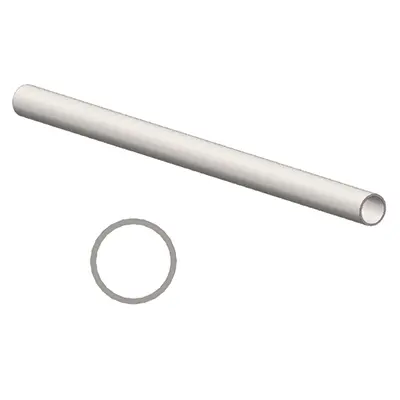
OPEN END ALUMINUM TUBE
An open-end aluminum scaffolding tube is a hollow cylindrical tube made of aluminum that has open ends on both sides. These lightweight tubes come in various sizes to match your exact needs, while their hollow design makes them easy to handle and transport around your job site.
Aluminum is a great choice because it resists corrosion, handles temperature changes well, and stays strong under pressure.
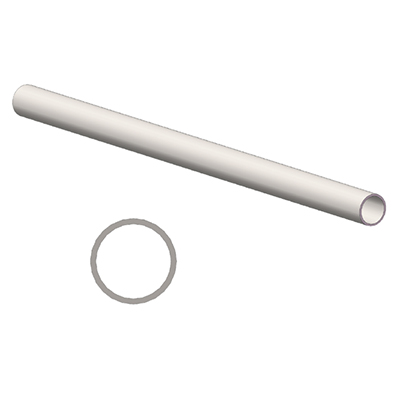
PLAIN END STEEL TUBE
A plain end steel tube is a type of hollow cylindrical pipe made of steel that has no threading or coupling at the ends. This means that the ends of the tube are straight and smooth, with no fittings or connectors attached.
Plain end steel tubes can be produced in a variety of sizes, thicknesses, and shapes, depending on the specific requirements of the application. They are commonly used in construction, manufacturing, and industrial applications.
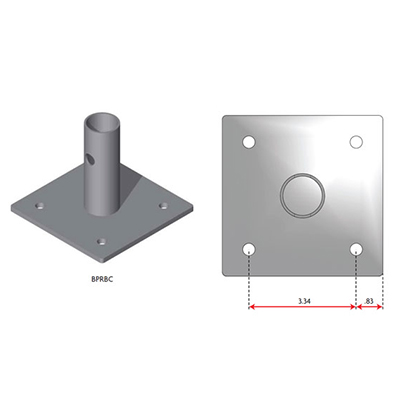
RIGID BASE PLATE
Base plates form the critical connection between your scaffolding and the ground below. Think of them as the feet of your structure – they spread out the weight evenly and keep everything steady, even when forces push from the side.
Setting up is straightforward – you’ll bolt the plate to your foundation, then attach your column on top. This creates a rock-solid base that transfers weight safely to the ground.
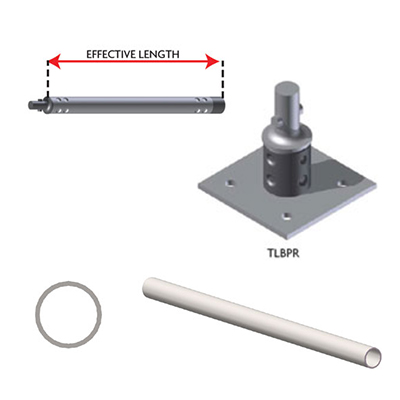
TWIST LOCK TUBE
A twist lock tube is a tube and clamp scaffolding part that locks into place instantly. These steel tubes come with a built-in locking plate and pin at one end, making assembly quick and foolproof on your job site.
Getting everything locked down is simple – just slide the pin into your ledger or brace, give it a twist, and you’re done. No more worrying about pieces rotating or slipping out of place while you work. This smart design saves you time during setup while giving you the peace of mind that comes with knowing your scaffolding is firmly secured.
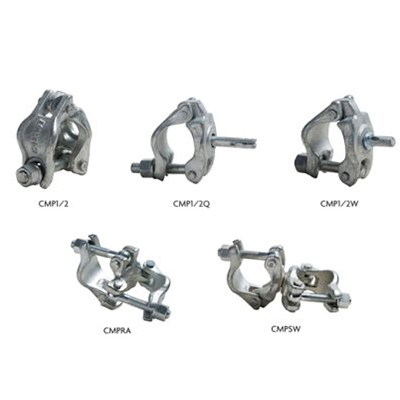
I-BOLT CLAMPS
I-bolt clamps are used to secure two or more objects together. They consist of a U-shaped metal bracket that is designed to fit around an object, with an I-bolt or eye bolt attached to the top of the bracket.
The I-bolt or eye bolt has a threaded shank, which allows it to be screwed into a threaded hole or attached to a threaded rod. Once the bolt is tightened, the U-shaped bracket clamps down on the object, holding it securely in place.
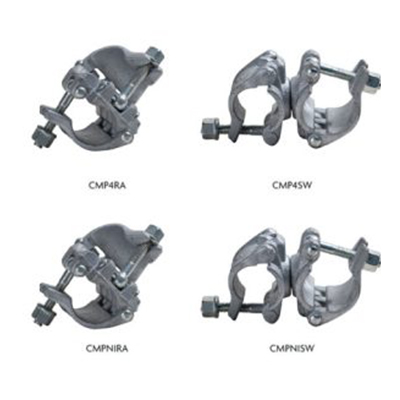
WIDE BODY CLAMPS
Wide body clamps are a type of clamping device that are designed to secure large and heavy objects in place. They consist of two clamping jaws that are connected by a threaded screw or bolt. The jaws are typically wider and heavier than those of standard clamps, which allows them to exert a greater clamping force.
The clamping jaws of wide body clamps are often coated with a non-marring material, such as rubber or plastic, to prevent damage to the workpiece or material being clamped. Some models also feature quick-release mechanisms that allow the jaws to be opened and closed quickly and easily.
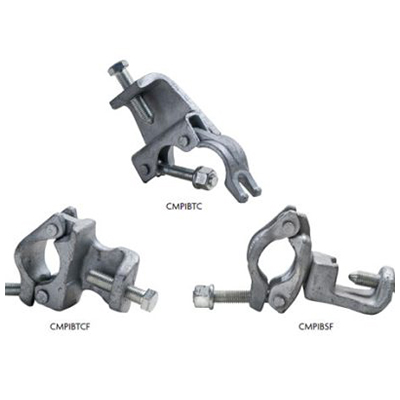
BEAM CLAMP
A beam clamp is used to attach pipes, ducts, electrical conduit, and other components to structural steel beams or other structural members. It consists of a U-shaped bracket that fits around the beam, with a threaded bolt or stud extending from the bottom of the bracket.
Beam clamps are commonly used in construction and industrial applications, where they are used to support HVAC systems, piping, and electrical systems
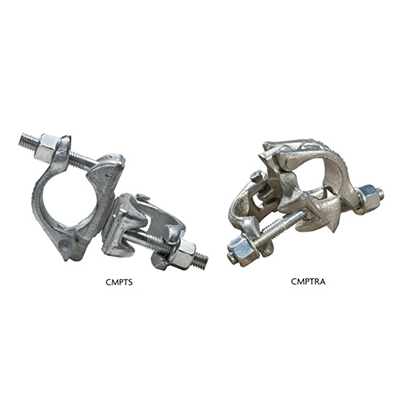
T BOLT CLAMPS
When you’re connecting tubes and beams, a quality t-bolt scaffolding clamp is what keeps everything secure. These T-bolt designs work with all your essential scaffold pieces, from basic tubes to guardrails and base plates, creating connections you can trust. Just tighten them down, and they’ll hold strong through your toughest jobs.
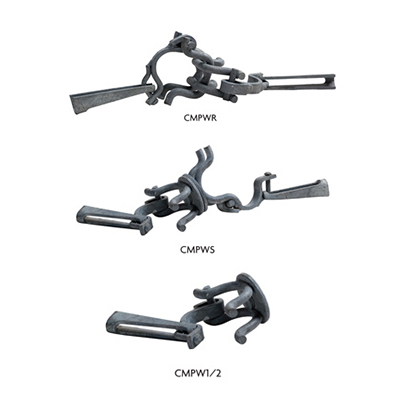
WEDGE CLAMPS
Wedge clamps consist of a pair of clamping plates, each with a tapered slot or groove cut into it. The workpiece is placed between the plates, and a wedge is inserted into the slots or grooves to tighten the plates around the workpiece. The wedge applies force to the plates, which in turn applies pressure to the workpiece, holding it securely in place.
Wedge clamps are preferred over other types of clamps in metalworking applications because they provide a high clamping force with minimal distortion or damage to the workpiece. They are also easy to use and can be quickly and easily adjusted to hold different sizes and shapes of workpieces.
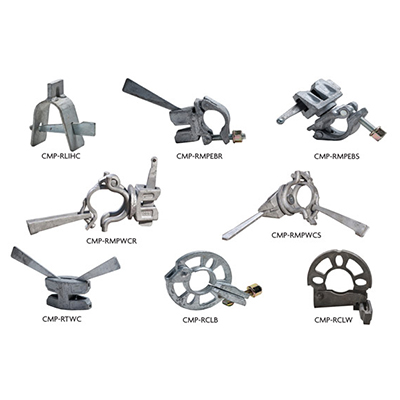
RING SYSTEM ACCESSORY CLAMPS
Ring system accessory clamps are commonly used in scaffolding systems. They are used to secure various accessories to scaffold tubes, such as ladders, scaffold boards, and guardrails.
Ring system accessory clamps consist of a circular ring that fits around the scaffold tube, and a bolt that passes through the ring and tightens onto the tube. The bolt is typically equipped with a wing nut or other type of easy-to-use fastener for quick and easy installation and removal.

TUBE COUPLERS
Tube couplers are a type of scaffold fitting used to connect scaffold tubes together in a secure and stable manner. They are an essential component of scaffolding systems, as they allow scaffold tubes to be joined together to create a scaffold structure that can support workers and materials.
Tube couplers consist of two hollow tubes, each with a protruding section on one end. The protruding sections fit inside the ends of the scaffold tubes and are held in place by a series of bolts and nuts. The bolts and nuts are tightened to create a strong and secure connection between the scaffold tubes.
Are you interested in purchasing tube and clamp scaffolding parts? Contact us today!
